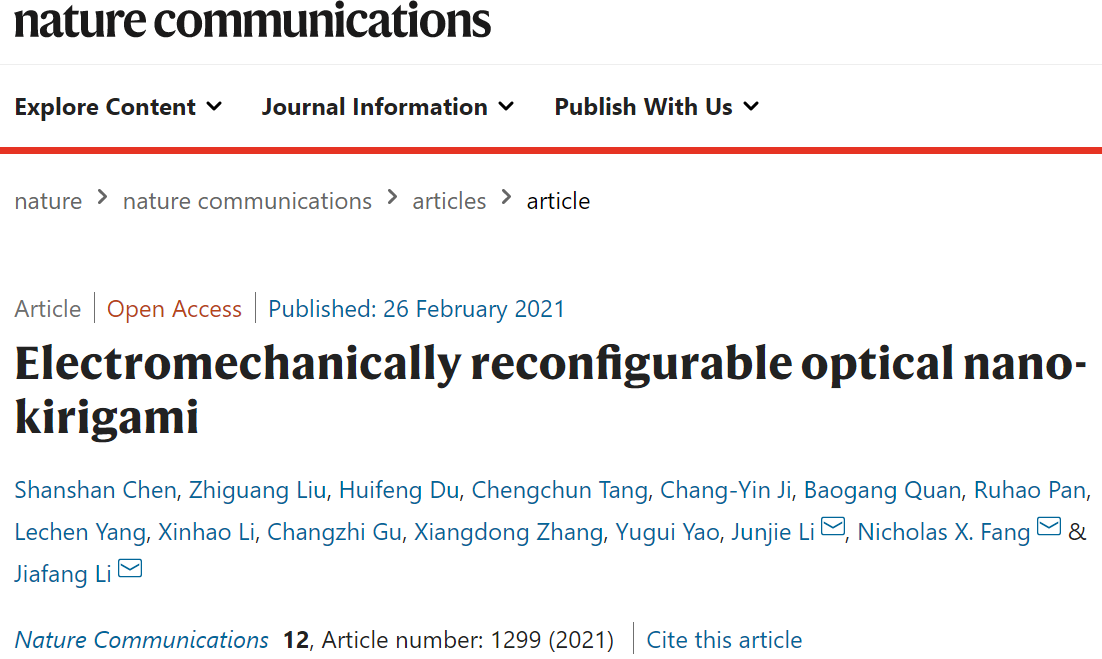Progress in NOEMS devices based on nano-kirigami deformation
来源: 作者: 发布时间:2022-05-26
The team of Professors Jiafang Li, Xiangdong Zhang and Yugui Yao from the School of Physics, Beijing Institute of Technology, and their collaborators have developed a new technology for on-chip electromechanical manipulation of light at nanoscale. The resonant optical reconfiguration with high contrast up to 494% and electromechanical modulation of optical helicity have been achieved in submicron nano-kirigami at near-infrared wavelengths. The results were published recently in Nature Communications 12, 1299 (2021).
With the development of nanomanufacturing technology, the advanced nano-opto-electromechanical systems (NOEMS) are promising for photonic circuits, optical switches, quantum devices, etc. However, in electromechanical systems, there is always a trade-off between the miniaturization of reconfigurable unit and the enhancement of modulation depth (determined by the spatial displacement), which limits the designs of NOEMS to only a few options (like the ultrathin cantilevers and membranes) and makes it highly challenging for submicron pixelated manipulation. In order to solve these problems, Professor Jiafang Li and his collaboration team proposed a nano-kirigami NOEMS device driven by the electrostatic force. The state-of-the-art practice of cutting, folding, bending, and twisting flat objects into versatile shapes, named kirigami or origami (origami does not include the cutting process), offered an unconventional approach for electromechanical reconfigurations.

Fig. 1 (a-c) Scheme for reconfigurable nano-kirigami. (d) 2D and calculated 3D deformed pinwheel in the gold layer. (e,f) SEM images of fabricated 2D pinwheels and the downward deformed 3D pinwheels after applying DC voltage of V = 65 V. Scale bars: 1 µm.

Fig. 2 (a,b) Experimental reflection spectra and modulation contrast of the pinwheels under different voltages. (c,d) Modulation contrast versus wavelength for the spirals and cross wires in the insets. (e) Measured CD spectra of initial 2D and deformed 3D three-arm pinwheels. (f) Calculated mechanical eigenfrequency of the pinwheels and spirals versus applied voltages.
As shown in Figs. 1a,b, the nano-electromechanical system is built on an Au/SiO2/Si substrate and operated via attractive electrostatic forces between the top gold nanostructure and bottom silicon substrate. Large-range nano-kirigami like 3D deformations have been clearly observed and reversibly engineered, with scalable pitch size down to 0.975 μm (Figs. 1c-f). By flexibly designing and optimizing nano-kirigami patterns, broadband non-resonant (Figs. 2a,b) and narrowband resonant (Figs. 2c,d) optical reconfigurations have been demonstrated at visible and near-infrared wavelengths, respectively. By scaling down the nano-kirigami units to submicron sizes, resonant optical reconfiguration with high contrast up to 494% has been achieved. On-chip modulation of optical helicity has been further demonstrated in submicron nano-kirigami at near-infrared wavelengths (Fig. 2e). The expected modulation frequency can be over 10 MHz (Fig. 2f).
Importantly, such reconfigurable nanoelectromechanical systems are compatible with the commercial nanofabrication technologies for further miniaturization and large-scale manufacturing. The proposed nano-kirigami principles and vertical actuation mechanism could be applied to a wide variety of material platforms for reconfigurable optical circuits and networks. Such small-size and high-contrast reconfigurable optical nano-kirigami provides advanced methodologies and platforms for versatile on-chip manipulation of light at nanoscale.




